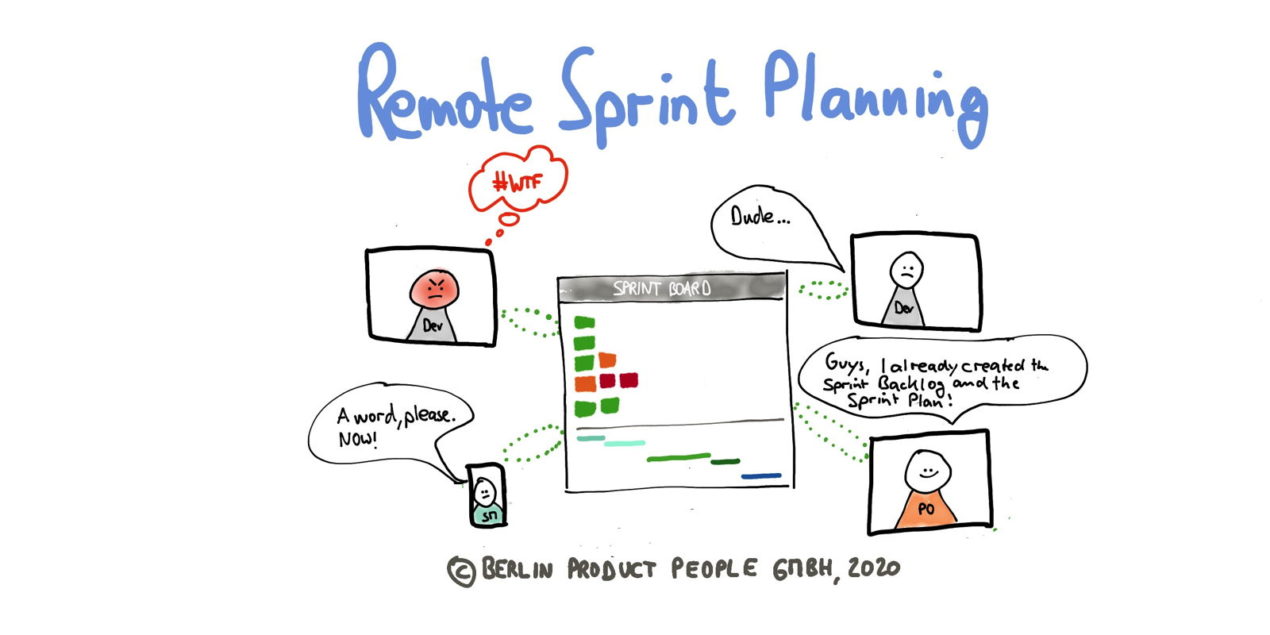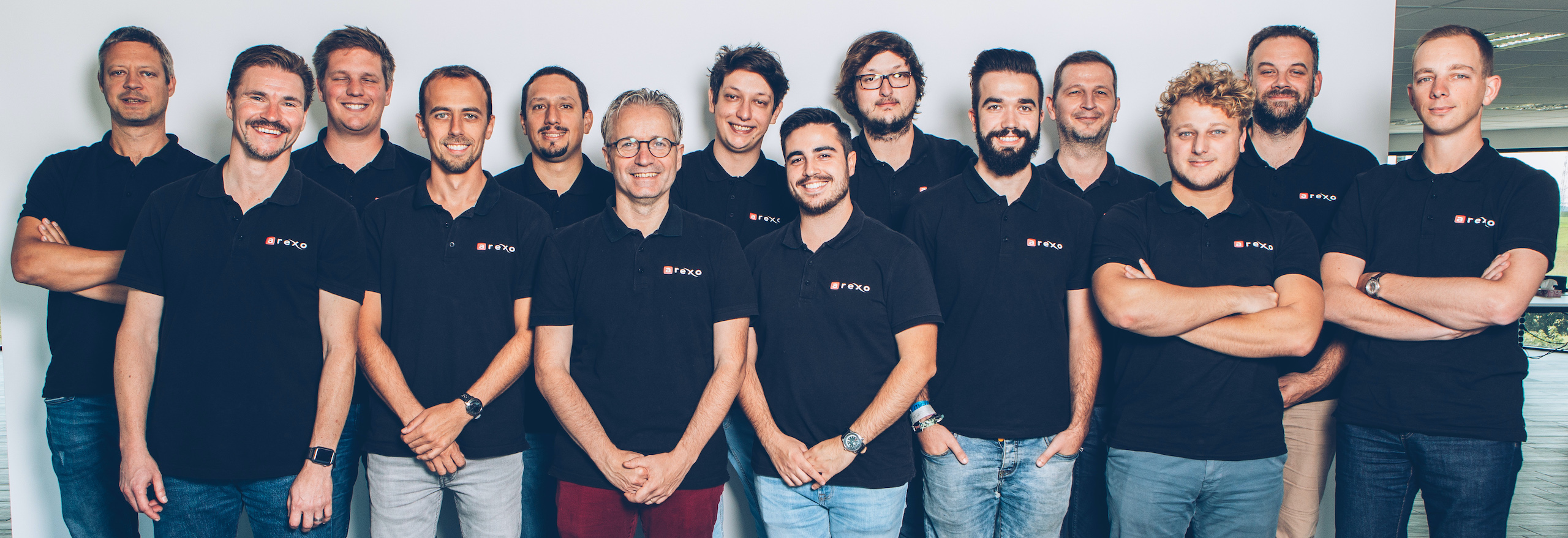Stay home! Stay Agile!
The context in which the world finds itself during this first half of 2020 forces each and everyone of us to reinvent themselves, review the organisation of their company and accept the new situation while making the necessary adjustments persistent. It sometimes is a question of survival for the company.
If it is certain that our lives tomorrow will not be the same, how can we remain Agile while working remotely?
This is a personal reflection based on my experiences and perception.

Thanks to the great folks at Berlin Product People for the image. Posted with their permission.
Keep in touch
If human beings have a tendency to center on themselves when isolated, Agility focuses on group relationships and interactions and you should keep that in mind as it is crucial at this period.
As a facilitator, you should pay attention that everyone keeps active bonds with the others. Here are a few tips to help you.
Maintain daily synchronisation meetings
Daily meetings, punctual sync calls, virtual coffees breaks and peer programming should be organised and encouraged.
Those will not replace the informal discussions in the hallways or at the coffee table but are essential to keep the information flowing.
Do not underestimate the importance of human relationshipsand the psychological impact that full remote working can have on people. The group cohesion that you patiently built over time can seriously suffer from it without you noticing.
Make sure to assess the mood at the beginning of every meeting and pay attention to everyone’s life.
Positive and encouraging messages should be communicated. The situation is not easy for anyone and the working from home context does not suit everyone. You need to be able to hear that even if you cannot really influence. It is important that the group is aware of that as the mood of a teammate that feels supported will have beneficial effects on everyone.
Reinvent yourself
In a world that keeps evolving, we need to reinvent our every day life and become actors of change. That is especially true in a crisis.
How can I keep giving visibility? What can I set up to facilitate exchanges of information and continuous improvement? What tools should I use to maintain spontaneity in the communications? Those are questions you could ask yourself.
The current crisis put a whole lot of tools under the spotlight. Even though they long existed, they were ignored by most. Be it virtual backlog management or remote retrospective tools, the offer is quite wide. The usage of those softwares used by full remote teams boomed these last months.
If the backlog is already handled in a virtual software in most places, including reports and graphs, it is less true for the other elements such as reviews and retrospectives. The market offers many opportunities that deserve our interest.
No doubt that you will find the one that suits your needs. If your team is already acquainted with some of them, you might easily adopt new tools that work hand in hand with your existing ones.
Do not hesitate to set up now boards to help with the daily tasks and reporting.
what about visual management?
This is the best way to showcase a team’s work and a indispensable tool in your Agilisation process. What tells more than a physical board set up no a wall or subliminally dispensed messages in the hallways? Obviously, the current context does not help you.
Implementing visual management from home is probably the most challenging task you will face. You will need to be creative to communicate the right message, the one that is both useful and representative.
I would argue that a collaborative tool, such as Notion or Confluence, is probably the best channel for visual management. It will enable you to share a graph, a picture, etc. while gathering feedback. Every person that will view the page will see the information and the reactions that followed.
You should preferably use very clear and unambiguous images and graphs. If additional information is required, add a short and explicit message.
An added benefit is that those tools usually keep a history of the changes. This can help you visualise the evolution of your communications.
Rigour and structure
When everyone is working from home, there are many aspects of the daily work that you cannot control. There is one, however, that you should insist on: time discipline.
Your meeting should start but one colleague is missing? You cannot go the easy way and grab them while passing next to their office. It is a much arduous task to gather everyone when you are 85 kilometers apart.
Make sure to insist that all participants join the meeting on time. It is a question of respect.
You should also pay attention to the time boxes you choose for your meetings and stick to it as our schedules tend to be filled with a continuous streak of calls. This is accentuated when working from home as we do not need to move from one room to the next: you are readily available in front of your screen. Respecting time boxes helps everyone to keep their schedule on tracks.
Next to that, you should keep your recurring meetings in order to help keep a good team spirit and provide a structure and a rhythm. This will help your team keep a feeling of “normality”.
The lost interest of in-person workshops
Workshops are much more interesting when they happen in-person. They enable us to get the most out of the group and assess body language more than words. When working remotely, this is much more complicated.
Spontaneous communication between team members are an important part of the Agile mindset. They are actually strongly recommended. It is true that the current context negatively impacts this aspect but you should not stop those sessions anyway.
What you will get out of such an exercise will not be optimal. This is why you will need to be creative to make it as lively as possible. There are many ideas on the Internet and you will certainly find the ones that suit you and your team.
When you hold meetings, you should also encourage the usage of the camera. This is not a revolution but it helps people connect better. It helps perceive body language, to some extent, and the understanding of your interlocutor. All this will help you fine tune your speech to get your message through.
You should set an example and always use your own camera first.
Work-Life balance
Working from home does not mean being available 24/7. That applies to your team but also to you.
Work-Life balance is more complicated to maintain when working space and living space are the same. Not everyone finds it easy to slide from one to the other.
Make sure to keep regular and decent working hours. Do not extend your days indefinitely. This would come at a cost in the long run.
The human body is not made to sit on a chair all day long. Make sure to move and breathe.
When possible, you should also dedicate a specific space for work. You can change every now and then but keeping a designated work area will help you transition and check out from work at the end of the day.
In order to counter the rhythm of the numerous meetings, try to plan “free time” slot in your schedule. This will enable you to take a break or work on your other tasks. By the way, this should not only apply to WFH situations.
And remember: go outside, move, breathe. This will boost you for the rest of the day.
Where is the fun in all this?
Energisers that need human interactions, such as clapping hands with your neighbour or helping each other make a knot out of a rope will not be possible through a webcam.
You will probably need to use less of those amusing tricks to start your meetings but you can also try to find new ones.
Even if you cannot use them now, you should take advantage of this period to enrich your fun box with those you like and you will try later.
Welcome change!
The current crisis brings many challenges in terms of way of working, mobility, work-life balance, flexibility and organisation. However, this should be an opportunity to reinvent the business world.
All this should evolve towards a common interest: the sustainability of work in tomorrow’s world.
It is only with ambitious objectives that we will succeed. The Agile mindset encourages us to welcome change and move forward.
Embrace change!
